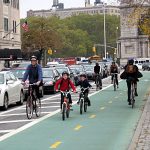Roundabouts in America have come a long way since they were first introduced. Today, traffic conditions have changed, traffic density has increased manifold, and these factors have raised questions about the effectiveness of roundabouts.
“Give way before entry” is the principle on which a roundabout is designed.

The first roundabout was built in 1960s in the United Kingdom and it appeared to be an effective solution for the exponentially increasing traffic in the developed nations. The US followed suit and a few roundabouts started to appear in major American cities. The roundabout model is still relatively new to the US, in comparison to traffic circles, which came into existence in the early 1900s. Compared to European countries, Americans are still adjusting to roundabout navigation and this has resulted in less efficient use of roundabouts.
Roundabout navigation depends mainly upon two factors: traffic lanes or traffic density and the behavior of the driver. The second factor is not only hard to predict, but it is highly variable, resulting in confusion while reaching or crossing through a roundabout. Secondly, at the time of inception of the roundabout model in the US, only motorist traffic was considered while designing. Gradually, as the number of cyclists and pedestrians increased, it gave rise to another problem- safety concerns for the non-motorists crossing the roundabout (especially bicyclists).
Are Roundabouts and Traffic Circles the Same Thing?
Many people ask this question and the answer is NO. Roundabouts and traffic circles might look the same, but they have huge differences.

1. A modern roundabout follows the yield at entry principle whereas a traffic signal takes the conventional approach of giving priority to the entering vehicle.
2. Modern roundabouts use smaller diameters whereas traffic circles have provision for both the small and large diameters. Small diameters are used for traffic calming and the large diameter circles are used to maintain the normal traffic flow.
3. The upper speed limit while crossing through a roundabout is 25 mph, whereas a traffic signal allows speeds above 25 mph.
4. Modern roundabouts minimize weaving movement within the circular section of the road. Traffic circles allow weaving and weaving sections are provided to take care of conflicting traffic movements.
5. As the entry speeds are low, the deflection angle is kept low for the modern roundabouts. Traffic circles have large deflection angles.
6.
7.
Modern Roundabouts – The Drawbacks
Roundabouts are popping up like mushrooms in the US. Old traffic circles are disappearing at an alarming rate and people are made to believe that modern roundabouts are the best thing that ever happened to humankind, which will not only channelize traffic, but also avoid intersection crashes and ensure the safety of non-motorists. However, there are certain drawbacks associated with modern roundabouts. What are the major disadvantages of having roundabouts in your city?
8. One important factor in the case against roundabouts is that they are, by design, slow. When you have a roundabout every mile or two, you might end up spending more time on the road and less time with your family. As compared to traffic circles, roundabouts increase the travel time by a huge margin.
9. In case of traffic congestion, the gap between vehicles becomes less. This can result in low-speed crashes and fender benders. Queue development can cause long lines at the entry points.
10. Higher maintenance costs make modern roundabouts an expensive solution for traffic control. Like traffic circles, very large roundabouts require huge land mass and long splitter islands further increase the cost.
11. Very large roundabouts eat up a lot of public space. Temporary widening and outside diameter space requirement increase the running cost of construction as well.
12. Roundabouts are not at all friendly for handicapped people, especially for visually impaired pedestrians. Additional pedestrian signals need to be installed to safe-guard them.
13. Cyclists suffer the most because of blind spots on a roundabout. Traffic rules allow inside lane turn-outs. In America this means that a vehicle in the inside lane- closest to the island- can turn right across the outside lane in order to exit. This can be unexpected to a bicyclist approaching behind the turning vehicle, and the bicycle can, at the same time, be in the motorist’s blind spot at an unexpected angle (neither behind, beside, or ahead).
14. Alternative pathways have to be designed to avoid roundabout exit accidents and that increases the cost of construction.
15. Roundabouts are not suitable for “platooned” traffic flow. Emergency vehicles like ambulances cannot make it through roundabouts easily.
The need of the hour is bringing forward an effective traffic management system that not only takes care of complex traffic conditions, but also costs less to manage. Cost effectiveness and optimum use of land are two key requirements of building an effective traffic navigation system, and unfortunately roundabouts do not fulfill both these conditions. Traffic circles are in use across the world and have been for quite some time. Many people are used to them. Roundabouts require educating people about navigation and crossing methods, which is a stressful exercise.
In America, roundabouts and traffic circles must go hand-in-hand. Major cities can easily accommodate roundabouts, but for the smaller cities, traffic circles can serve the purpose without waste of money or land. Even the traffic circles need to be improved because the traffic density and traffic behavior has changed a lot in recent years.


